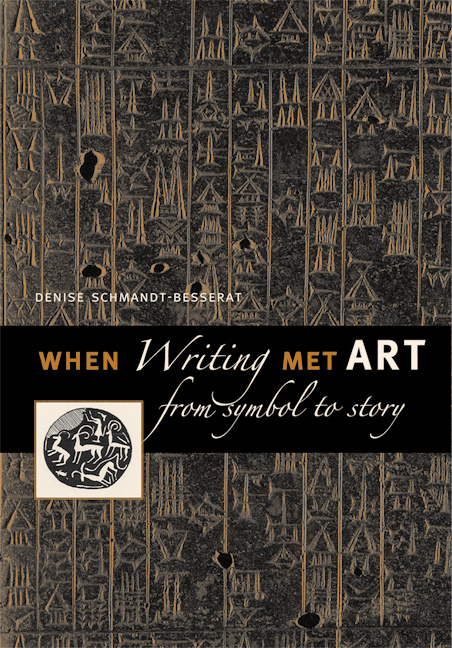Denise Schmandt-Besserat: When Writing Met Art: From Symbol to Story (2007)
Filed under book | Tags: · antiquity, archaeology, art, art history, history, mesopotamia, middle east, painting, writing

“Denise Schmandt-Besserat opened a major new chapter in the history of literacy when she demonstrated that the cuneiform script invented in the ancient Near East in the late fourth millennium BC—the world’s oldest known system of writing—derived from an archaic counting device. Her discovery, which she published in Before Writing: From Counting to Cuneiform and How Writing Came About, was widely reported in professional journals and the popular press. In 1999, American Scientist chose How Writing Came About as one of the “100 or so Books that shaped a Century of Science.”
In When Writing Met Art, Schmandt-Besserat expands her history of writing into the visual realm of communication. Using examples of ancient Near Eastern writing and masterpieces of art, she shows that between 3500 and 3000 BC the conventions of writing—everything from its linear organization to its semantic use of the form, size, order, and placement of signs—spread to the making of art, resulting in artworks that presented complex visual narratives in place of the repetitive motifs found on preliterate art objects. Schmandt-Besserat then demonstrates art’s reciprocal impact on the development of writing. She shows how, beginning in 2700-2600 BC, the inclusion of inscriptions on funerary and votive art objects emancipated writing from its original accounting function. To fulfill its new role, writing evolved to replicate speech; this in turn made it possible to compile, organize, and synthesize unlimited amounts of information; and to preserve and disseminate information across time and space.
Schmandt-Besserat’s pioneering investigation of the interface between writing and art documents a key turning point in human history, when two of our most fundamental information media reciprocally multiplied their capacities to communicate. When writing met art, literate civilization was born.”
Publisher University of Texas Press, 2007
ISBN 0292713347, 9780292713345
134 pages
Philippe Forêt, Andreas Kaplony (eds.): The Journey of Maps and Images on the Silk Road (2008)
Filed under book | Tags: · asia, buddhism, cartography, china, geography, islam, mapping, middle east, silk road

“This book covers new ground on the diffusion and transmission of geographical knowledge that occurred at critical junctures in the long history of the Silk Road.
Much of twentieth-century scholarship on the Silk Road examined the ancient archaeological objects and medieval historical records found within each cultural area, while the consequences of long-distance interaction across Eurasia remained poorly studied. Here ample attention is given to the journeys that notions and objects undertook to transmit spatial values to other civilizations. In retracing the steps of four major circuits right across the many civilizations that shared the Silk Road, The Journey of Maps and Images on the Silk Road traces the ways in which maps and images surmounted spatial, historical and cultural divisions.”
Publisher BRILL, 2008
Volume 21 of Brill’s Inner Asian library
ISBN 9004171657, 9789004171657
243 pages
review (Ron Sela, Journal of Inner Asian Art and Archaeology)
review (Liano Cai, International Journal of Middle East Studies)
Jonathan Bloom: Paper Before Print: The History and Impact of Paper in the Islamic World (2001)
Filed under book | Tags: · china, history of technology, islam, middle ages, middle east, paper, technology

“Like the printing press, typewriter, and computer, paper has been a crucial agent for the dissemination of information. This engaging book presents an important new chapter in paper’s history: how its use in Islamic lands during the Middle Ages influenced almost every aspect of medieval life. Focusing on the spread of paper from the early eighth century, when Muslims in West Asia acquired Chinese knowledge of paper and papermaking, to five centuries later, when they transmitted this knowledge to Christians in Spain and Sicily, the book reveals how paper utterly transformed the passing of knowledge and served as a bridge between cultures.
Jonathan Bloom traces the earliest history of paper—how it was invented in China over 2,000 years ago, how it entered the Islamic lands of West Asia and North Africa, and how it spread to northern Europe. He explores the impact of paper on the development of writing, books, mathematics, music, art, architecture, and even cooking. And he discusses why Europe was so quick to adopt paper from the Islamic lands and why the Islamic lands were so slow to accept printing in return. Together the beautifully written text and delightful illustrations (of papermaking techniques and the many uses to which paper was put) give new luster and importance to a now-humble material.”
Publisher Yale University Press, 2001
ISBN 9780300089554
320 pages
review (Richard W. Bulliet, Technology and Culture)
review (Farid Mahdavi, Journal of Interdisciplinary History)
review (Timothy J. Reiss, Speculum)
commentary (Jussi Parikka, August 2013)
PDF (updated on 2016-12-23)
Comment (0)
